
Nick MacKinnon is a freelance teacher of Maths, English and Medieval History, and lives above Haworth, in the last inhabited house before Top Withens = Wuthering Heights. In 1992 he founded the successful Campaign to Save Radio 4 Long Wave while in plaster following a rock-climbing accident on Skye. His poem ‘The metric system’ won the 2013 Forward Prize. His topical verse and satire appears in the Spectator, and his puzzles and problems in the Sunday Times and American Mathematical Monthly. Email: [email protected]
Turbine 43: Oxenhope Stoop Hill SD 994 345 ///orders.spine.regrowth
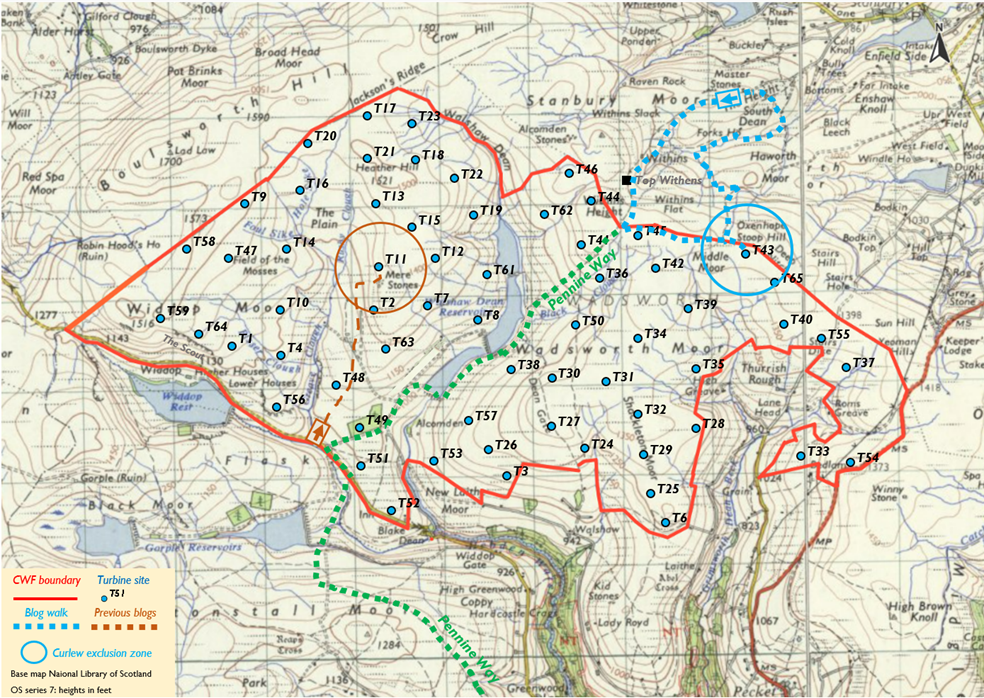
17 January 2024 It has snowed overnight through –10°C air, so the lying snow is squeaky, the crystals holding themselves apart on thin necks: atairranaqtuq is the Inuit word. On days like this the path to Top Withens is covered in human prints by lunchtime, but this morning I am first, with only the Y-pattern of a rabbit and arrow track of a grouse in front of me. The three lasers at Haworth Parsonage can dazzle everything in the Upper Worth Valley, so I tell myself ‘No Brontës today’, and am soon beyond the ruin of W******** H******, on the flagstones of the Pennine Way.
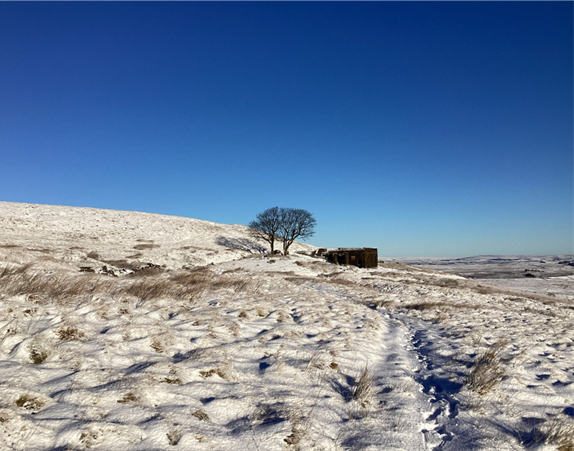
2025 is the Diamond Jubilee of the Pennine Way, a sinuous institution of our democracy. It was the brainchild of Tom Stephenson, who wrote an article in the Daily Herald in 1935:
“Wanted: a long green trail. When two American girls wrote asking advice about a tramping holiday in England, I wondered what they would think of our island, particularly of the restrictions placed in the way of those who wished to see some of our most captivating scenery. If, at the end of their tour, these visitors from across the Atlantic are over-loud in their praises of their native “Land of Liberty,” who shall blame them? They mention their acquaintance with the Appalachian Trail, a footpath that runs for 2,000 miles through the Eastern States from Maine to Georgia, established by tramping, mountaineering and other open-air organisations, and generously aided by the Government and State authorities. Now this path has been eclipsed by the John Muir Trail which reaches from the Canadian border through Washington, Oregon and California to Mexico. For 2,500 miles without any slogging on hard roads, one may follow this track over lofty peaks, by deep-cleft canyons and through great National Parks and reserves saved for all time from spoilation by unplanned and irresponsible building. After allowing for difference in geographical scale, what can we in England offer to compare with these enterprises?”
It took Stephenson 30 years to get the Pennine Way on the map, and he walked it as a 72-year old. Landowners were the main obstacles, not least Manchester Corporation, who said common people not wearing plus-fours would contaminate their reservoirs, which were then our reservoirs. At the public inquiry in 1954 Dr Wilfred Fine, a medical witness called by the Ramblers’ Association, said that typhoid was now carried by only 2.9 per million British people, and as ramblers would be younger, a much lower figure would apply, so that, “in three hundred years, in round figures, two carriers could be expected to pass along that part of the Pennine Way.”
The 2024 Spine Race, the whole Pennine Way from Edale to Kirk Yetholm, has been through this week. I don’t know who said, “The reason men are faster than women at running is that the races are nowhere near long enough”, but Jasmin Paris put down an imperishable marker in 2019 when she became the first woman to win the Spine Race against all comers, and in a record time. She expressed breast milk for her baby during her breaks.
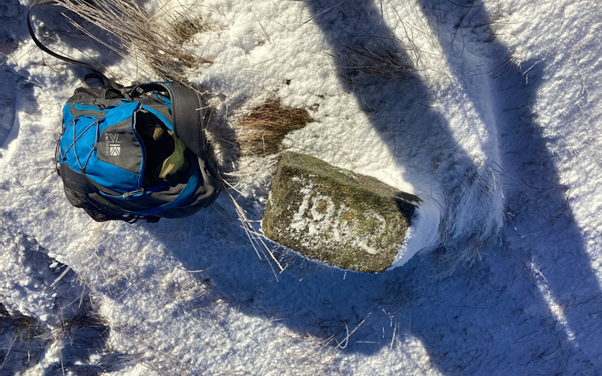
The PW levels out on the pass; today it feels like an alpine col. A right of way (not marked on the OS 25000, but there was a rotting sign in 2019) leaves the flagstones, passing a 1902 boundary stone, and the rest of the way to Turbine 43 lies along the watershed, the very edge of Mr Bannister’s proposed wind farm, and a popular high-level walk from Haworth.
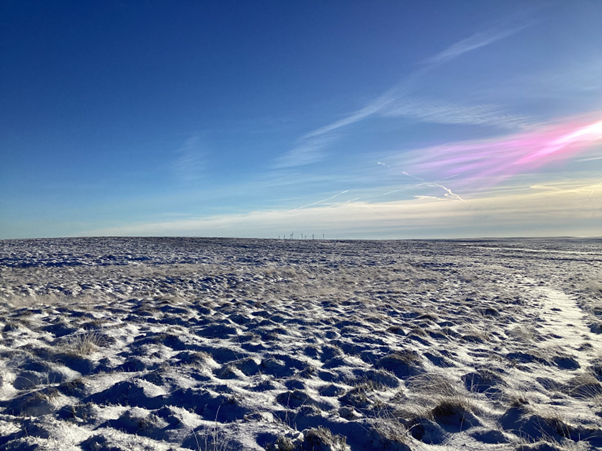
The snow is still squeaking, and only when I stop can I hear the chat of the grouse, which is mostly “Go back! Go back!” as though they had been trained by Mr Bannister, using a pocketful of Heather Treats and a double-barrelled shotgun. At last, I meet two ecstatic women and their dogs. The lurcher is “out of sorts, but pulling himself together” and comes over to tell me so. The collie is engaged in her Sisyphean task of rounding up the whole world so she can shut the gate and be done with it at last. We share our astonishment at the day and the place, and they carry on to T45 while I head for T43. I won’t meet anyone else until I’m back in the valley. A short rise finds the standing stone at the top of the hill.
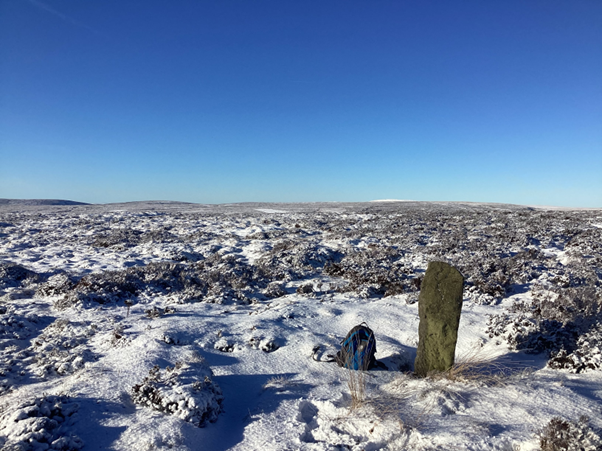
The impact on landscape and habitats of this wind farm is grim, but some of its turbine sites are especially crass, and T43 is one of them. “Stoop” is Yorkshire dialect for a standing stone on a boundary, stemming from the Old Norse word stolpi: a post. Oxenhope Stoop Hill is the climax of the view up the Worth Valley from the blocks of flats in Keighley and was one of the places Keighlians were drawn to for freedom during lockdown, particularly the Muslim community, particularly on Fridays, and particularly women.
As I walk inside the perimeter of the turbine foundation ///what3words produces uncanny commentary like an electronic Ouija board.
///glorified.offer.trickle
Does this refer to the community fund offered to the people of Calderdale in return for their submission?
///incurs.flattens.bleak
Startlingly exact after an uncertain beginning.
///reveal.spent.countries
An indictment of the way T43 will degrade and deplete the peat resource? A commentary on our relentless selling of the family silver, so that all we have left to pawn to the Saudis are the wild places?
I settle for the optimistic incantation ///orders.spine.regrowth to mark T43, in tribute to Jasmin Paris, and the tireless work of Jenny Shepherd, who has campaigned for years to stop Mr Bannister burning the peat on our spine, only to find he now proposes to dig it up, dry it out, and scatter its sequestered carbon to the winds.
The snow makes casting about for the ribbon of path down on the Haworth side even more difficult than usual. You can’t see the line until you are committed to the tussocks and heather. It runs just east of the grouse butts, down to the strange col between Stoop and Harbour Hills, which is a mini-version of the ‘great nick’ above the Watersheddles reservoir, west of the Wolf Stones. A lake was impounded in the Worth valley at various levels by the Aire glacier, 10,000 years ago, and these cols were cut and smoothed like jug lips, in the case of ‘great nick’ allowing Yorkshire’s water to slop back into Lancashire. (See here p235, but all of this long paper is interesting if you live nearby and wonder about the landscape.)
Under new snow, the eroded path down the B**ntë Falls to the B**ntë Bridge will be lethal, so I circle Harbour Hill clockwise on the neck-breaking brink of Crumber Dyke, and only meet the Pennine Way again at our gate, walking over ‘snow that was once squeaky but is now silent’: qiqirrituq.
+++++++++++++++++++++++++++++++++++++++++++++++++++++++++
The various groups campaigning against Calderdale Wind Farm have come together as Save and Restore Walshaw Moor.
We are hoping that local artists and writers will make a creative response to the wind farm in each blog. Get in touch with Nick by email if you would like to make a creative response of any kind (painting, poem, music, …) This one is by Vicki Haythornthwaite Millar who was brought up at Scar Top Farm by Ponden Reservoir when there were far more lapwings and curlews than there are now, and has lived in Riddlesden since 2005.
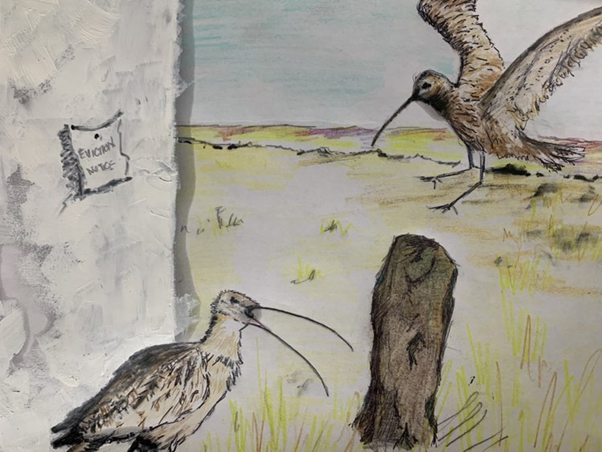
This is the 2nd in a series of 65 guest blogs on each of the wind turbines which Richard Bannister plans to have erected on Walshaw Moor. Turbine 11 has already been described. To see all the published blogs – click here.
[registration_form]
I personally think that they are not bothered about the landscape and its an easy way to make more money
I agree, but I have my hopes that the friends and family of Mr Bannister will help him come back to himself. If we can work together to restore the moor it will be an incomparable legacy.
Another excellent piece Nick!
Thank you Graeme. Come on a walk!
All the years we have campaigned for Walshaw Moor to be more sensitively
(and legally ) managed and now we face this. Local campaigners still have a vision that this wonderful moorland with so much wildlife and cultural heritage could be restored to its full glory as a functioning blanket bog and free from the intense killing of the gamekeepers traps. The level of local opposition to the windfarm is growing as more discover the potential impact.People are coming together in a way I have not seen before.We need as much support from as many quarters as possible.Please support us in our campaign to stop this massively damaging proposal.
Thank you for your comment Ros, and for the years of patient work. Come for a walk to a turbine site some time soon. The best outcome for everyone, and the good name of the Bannister family is to restore the moor. It would be wonderful if this foolish plan catalyzed that outcome. The clownish positioning of the turbines is down to the consultants. Mr Bannister’s first step should be to fire them. They have put a turbine right next to the NT at Blake Head, right behind Top Withens, and right on top of the Dove Stones. Then they have scattered about 50 on the deepest peat on the site. It is as though the consultants are secretly working for us.
Great stuff Nick. I was especially happy to be introduced by your scholarship to the Proceedings of the Yorkshire Geological and Polytechnic Society paper which is a wonderfuly informative evocation of our ancestors care and attention to the history of the Landscape; and of course to the unforgettably named H Brantwood Muff who I note ended up a colonial administrator reporting on the geolgy of the “East African Protectorate” where on one understanding humanity itself originated……
Thank you Richard! Now have you chosen a turbine site yet?